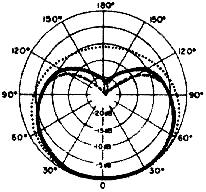Live Microphone Use
There are many microphones that could do the job, but what about which ones could do the job well. There are microphones that could be cheap with very easy feedback problems. Feedback is simply how a frequency could be captured from a microphone from the speakers and then amplifying it many times, which could hurt your ears, and possibly damage your speakers. To avoid feedback in general, a sound system’s volume should be set low as possible for the job.


(images from Kelly Industries and Shure)
This is a polar pattern of how a microphone not exactly but very similarly as a Shure SM58 would pick up a signal. At 0 degrees and directly into the microphone is the best place to give sound input. A many people do not know this and will sing/talk over the microphone and not be heard as well to the audience. Plus if a sound man is trying to increase the volume so the audience could hear, feedback is more likely to occur. Here is a PDF spec of a Shure Beta 58A (Shure, Web Spec) microphone. Notice that the polar pattern above is cardioid (heart) shaped. This helps eliminate feedback from a sound source like a monitor. Not all microphones are designed this way, in the Beta 58 PDF, the polar patterns had a sensitivity around 180 degrees. It helps a lot to know the polar pattern of a microphone to lessen possible feedback. There is always a different microphone for the job. Some recording microphones not designed for stage use sometimes have a figure 8 pattern or a full circle pattern to capture a whole room like in an auditorium for recording
< Introduction | Mics | Mixers | Effects | Poweramps | Speakers | Works Cited >